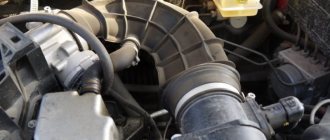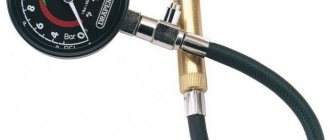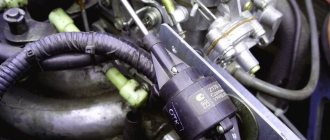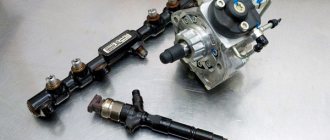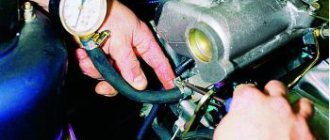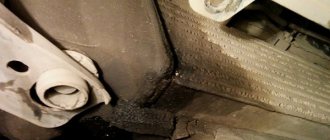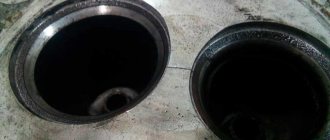Every year the share of cars with diesel engines is increasing. And if previously such engines were associated with commercial vehicles, now tractor engines can often be seen on small cars. Such a high popularity of diesel cars is due to low fuel consumption and high torque. Due to the turbine, the power of such cars is no less than that of gasoline cars, and the consumption is one and a half to two times lower. But you need to understand that diesel is a completely different philosophy. These internal combustion engines have their own differences and repair features. In today's article we will look at a fairly common problem - air leaks in the diesel fuel system.
Symptoms
Usually, in this situation, the engine starts well when cold, but further operation at idle raises questions. Among the characteristic symptoms are:
- Shaking and tripping of the power unit.
- Slow response to the gas pedal.
If the problem continues to be ignored, a long and difficult start-up of the internal combustion engine may occur. Sometimes the situation reaches the point where starting the car becomes completely impossible. There is too much oxygen in the system for the mixture to ignite properly.
Causes of suction
There are many reasons for this problem. This:
- Rotten clamps and dried out fuel hoses. This is the most popular reason why air appears in the return line of the diesel fuel system. This problem is especially relevant for car owners with plastic hoses. Unlike brass ones, they have quick releases. Of course, replacing such a hose is much easier. However, it is the quick releases that turn out to be the most fragile in this element. As a result of vibrations, the plastic wears out and the rubber sealing rings wear out. Often a similar problem can be found on cars with a mileage of 200 thousand kilometers.
- Rusty tubes, especially at the entrance to the gas tank. The problem is relevant for cars with high mileage or for cars that have not been used for a long time (more than six months).
- Poor filter or booster pump seal.
- Violation of the tightness of the return line and the fuel injection pump drive shaft.
- Damage to the pump cover and the axis of the diesel supply control lever.
It is possible that air in the fuel system of a diesel engine (Volkswagen or another brand of car) enters through the fuel injection pump itself. However, it is better to entrust all diagnostic operations and repairs of this pump to professionals, otherwise there is a risk of incorrectly assembling the mechanism. Among the common causes of air leaks into the fuel system of a diesel engine is a poor-quality filter or its loose fit to the surface. This is the most banal option.
Note that air leaks into the fuel system of a diesel engine appear when both the direct and return branches are damaged. Due to the design features of the injection pump or engine, some of the fuel may remain in the pump, which ensures good starting. However, with further work, characteristic problems appear. The engine does not have enough fuel, and it begins to “suffocate” without it.
Possible places for air leaks
Airing of the fuel supply system can occur either unexpectedly or as a result of recently carried out repair work. Air can enter the diesel fuel system from different places, and the total number of potential “windows” will directly depend on how many years the vehicle has been in operation and under what conditions a particular vehicle is operated.
The fuel system becomes airtight both when there is a loss of tightness in the main line and in the return line. Failure of seals in the lines causes diesel fuel to flow back into the fuel tank. The engine can start after being idle due to the fact that fuel remains in the cavities of the fuel injection pump, but then the diesel engine quickly stalls and will not start again.
Airing can be caused by a seal failure on the fuel priming pump. The line for the return flow of fuel at the injectors (return) deserves special attention, since leakage of the fuel lines in this area is becoming a frequent occurrence.
Another place for air to enter the fuel supply system may be the fuel pump itself. Failure of the drive shaft seal or pump cover will lead to air leakage from the injection pump. The design also contains other places on the pump that can allow air to pass through. We would like to add that diagnostics of the high-pressure fuel pump must be carried out by diesel equipment repair specialists.
How to check?
To make sure that the cause of unstable engine operation is air leaks, you need to visually analyze the flow of fuel into the cylinders. To do this, turn the engine with the starter for about 20-30 seconds. So we will fill the exhaust tract with gases, after which we will analyze them. If there is something wrong with the fuel system, a small amount of smoke (usually gray in color) will come out of the pipe. If the exhaust has a bluish-gray tint, it means that a large volume of oil is entering the combustion chamber.
How to bleed a diesel fuel system? 3 ways
The article will tell you how to bleed a diesel fuel system. The urgent need to convey to some of the drivers of diesel cars who mistakenly believe that it is enough to just bleed the pump, forced us to ask experts to provide competent information. The option for bleeding the diesel system described above is completely unsuitable. The fact is that if there is mechanical damage in the system, such a procedure is extremely dangerous.
How to bleed a diesel fuel system using other methods? This will be discussed in the publication.
Professional diagnostic methods
The classic way to check the tightness of this system is with compressed air. To do this you will need a small amount of fuel and chalk. The last thing you need to do is rub the tubes and hoses through which the fuel moves. Next, remove the fuel intake from the tank and remove the coarse filter. Compressed air is supplied to the fuel intake at a pressure of no more than 0.5 kgf/cm2. At home, this pressure can be taken from a regular tire tube or wheel. Next, all tubes and hoses are inspected. Particular attention is paid to connection points. As practice shows, in 80 percent of cases the reason lies here. In such areas, the chalk will darken as the fuel flows out.
Please note that damage may also be of a “valve” nature. That is, air can only enter the system in one direction.
Let's consider another method. To accurately diagnose the air in the diesel fuel system, it is necessary to disconnect the injection pump from the lines and power it from another container with fuel. Usually a three-liter bottle and two meter-long durite hoses are taken. To prevent them from coming off, you also need clamps of appropriate sizes.
What's next?
So, we disconnect the hoses from the pump and install recently purchased ones in their place. We lower their ends into a container with fuel (it is important that it is as clean as possible and without traces of water). We secure the hoses so that they do not move, and start the engine. This way we will find out which of the highways was damaged. It is advisable to replace the deformed element immediately.
At the end of the procedure, remove air from the fuel chamber of the pump. It is not recommended to simply rotate the starter for this.
How to properly get rid of air in the system?
No matter how hard we try to carefully replace the old hose with a new one, there will still be air in the system. But how to remove it correctly? There are several ways to pump air in a diesel fuel system:
- A container with diesel fuel is being prepared. It should be located above the level where the pump is fixed. Then we find an area where there is a “return” fitting for draining fuel. This area should be washed thoroughly to prevent dirt from entering (the diesel fuel system is very sensitive to the slightest specks). Next, the fitting bolt is unscrewed and air is pumped out through the hole. You can pump it out with a vacuum pump (a syringe will also work). The operation is carried out until the fuel itself begins to flow. After this, the bolt is screwed into place and the engine starts.
- The fuel supply hose is removed from the injection pump and the airy diesel is sucked out until it begins to flow in a dense stream. Afterwards, the hose is put on the fuel injection pump fitting and crimped with a clamp. Next, unscrew the screw of the return line fitting. There is no need to pump out the air - it will go away on its own. Next, start the engine and let it run for several minutes to finally get rid of air particles.
- The filter mounting bolt is unscrewed. The last element is not removed. Next, you need to pour some fuel into the bolt hole. After this, the bolt is screwed into place. Loosen the fitting nut on the second or first injector. Then you need to start the engine. when diesel starts spraying out from under the injector nuts, they need to be screwed back in. This method is relevant if the cause of the leak is a loose fit of the filter itself.
These are the main ways to remove air from the system. Please note that air may appear even if the fuel lines and other components are in good condition. It is enough to drive a certain distance on a “dry” tank. The air will be automatically sucked in by the pump and then supplied to the nozzles. You shouldn't let your car get into this state. It is advisable to refuel the car no later than the lamp on the instrument panel comes on.
Why does air get into the fuel system?
Most often, the fuel line becomes airy for the following reasons:
- Worn and damaged fuel system. This includes broken fuel filter and pump cover seals, rusted fuel pipes, and leaky hoses.
- Air may also appear in the system if the fuel in the gas tank has run out. At first the engine simply stalls, but after refueling it still does not start immediately. To remove air from the fuel system, the fuel system is bled. To do this, you need to turn on the ground on the ignition switch and pump the gas pedal for some time.
- In some cases, gas bubbles can enter the diesel fuel through the filter. This usually happens if it is installed incorrectly or if the filter itself is of poor quality. In this case, the car also stalls.
Another reason why air leaks into the fuel system is damage to the fuel injection pump seals. If this happens, the fuel lines become depressurized, causing diesel fuel to begin flowing back into the gas tank.
Could there be leaks in other places?
It should not be ruled out that air can penetrate through other places into the engine. So, after diagnosing the fuel hoses, you should pay attention to the intake manifold.
Thus, oxygen that is not taken into account by sensors (mass air flow or absolute pressure) penetrates into the engine along with the fuel, which is the cause of unstable operation of the internal combustion engine. Among the reasons, experts highlight:
- Overheating, as a result of which the tightness of the gaskets is disrupted.
- Mechanical impact (for example, during careless repairs).
- Exposure to carburetor cleaners. This is a very caustic product that not only cleans dirt in the intake manifold, but also corrodes all rubber elements, including the sealant.
The most difficult thing to find is the leak between the intake manifold and the engine cylinder head. Oxygen can also enter due to loose injector seals or damaged air ducts. Let's consider what methods can be used to detect a problem if it does not arise in the fuel line:
- When oxygen enters the path after the flow meter, you should unscrew the air pipe with the sensor from the filter housing and start the engine. In this case, the part with the sensor is covered with your hand. If there is no suction, the engine should stall. If the engine continues to run, it means there is air in the diesel fuel system (Renault Kangu is no exception). In this case, the “sick” area will emit a characteristic hissing sound. The location of air leaks into the fuel system of a diesel engine must be found by ear.
- The problem can be diagnosed by spraying likely areas with mixtures such as VD-40. It is necessary to spray on the rubber pipe from the flow meter to the valve cover. Also spray the place where the block head connects to the intake manifold. Another area is the injector gaskets.
Airing the fuel system of a diesel engine
If the fuel system of a diesel engine is contaminated, the malfunction may appear constantly during startup after a long period of inactivity, or may not be noticeable for a long time. This depends on the intensity of air leaks. The main symptoms of air entering the diesel fuel system, regardless of the modification of the power unit, are:
- the diesel engine starts easily when cold, but further operation of the internal combustion engine is not stable;
- a diesel engine may shake and shake after starting, reactions to pressing the gas pedal become sluggish and slow;
- After parking, the unit must be turned with the starter longer and longer, then seizure occurs and the symptoms described in the first case are repeated.
- As the malfunction progresses, the diesel engine no longer starts from the starter; it is not always possible to start the engine even with the help of starting devices or a jerk in tow;

